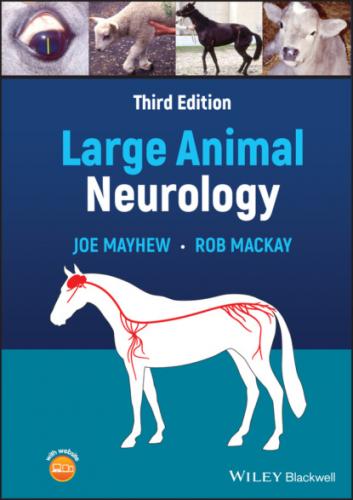Library of Congress Cataloging‐in‐Publication Data applied for [HB ISBN: 9781119477037]
Cover Design: Wiley
Cover Images: Courtesy of Quentin Roper, Courtesy of Joe Mayhew
Preface to third edition
For this third edition of Large Animal Neurology, we have enlisted Rob MacKay as coauthor to help us keep up with current trends and to maintain a reasonably worldwide—albeit somewhat Anglosphere—perspective.
As with previous editions, the general structure of the book consists of three parts. Part I (Chapters 1–4) covers the background disciplines required for the evaluation of neurologic cases; Part II (Chapters 5–30) provides concise overviews of the commonly encountered, major clinical presenting scenarios; and Part III (Chapters 31–38) offers an extensively resourced discourse of most neurologic diseases of domestic large animals following an etiologic category. Readers thus can approach the text with a view to updating their evaluation of suspected clinical neurologic patients (Part I), with a specific clinical syndrome in mind (Part II), or to delve into details on most of the specific neurologic diseases of large domestic animals (Part III).
Since the second edition of 2008, genetics and modern imaging techniques, in particular, have had a major impact on large animal neurology. Despite their profound utility, these diagnostic tests are not perfect. Thus, even dramatic and clearly defined changes seen on an MR or a CT image of a patient with a neurologic syndrome does not always indicate cause and effect. Likewise, as our genetic modeling of many diseases unravels, particularly of those with complex genetic characteristics, identifying a genetic association with a particular disorder does not mean that the patient’s signs are due solely to that inborn—or even acquired—genetic fingerprint. Therefore, as with all diagnostic ancillary aids we use, the results must be taken in conjunction with the results of repeated examinations to help formulate the most appropriate diagnostic and therapeutic plans. It also must be considered before undertaking any test, whether the results, considering their margin of error, will inform clinical management to a degree that benefit outweighs risk and cost. Otherwise, we might be better off not undertaking them.
Another ongoing revolution of tools is in modern IT equipment and apps, not least, in a specialty so dependent on visual observation and pattern recognition, as a means of instantly sharing images and videos of cases to better indicate clinical findings. Thus, it made sense to develop a library of still and motion images of clinical material to share with readers in this edition of Large Animal Neurology. The video library is not only a compilation of a wide variety of cases we have been fortunate enough to see but, more importantly, provides examples of actions, movements, postures and syndromes, and particularly visual examples to assist in the definition of clinical signs and syndromes such as bizarre behavior, the ataxias, sleep attacks, tetany, and tremor.
As with most clinicians and neurologists, we have likely reviewed thousands of videos and images of clinical cases over the years. Very often, new aspects of a case come to light after multiple viewings at both normal and slow speeds. Similarly, and particularly with cases that are enigmatic or show fluctuating signs, by returning to study the patient or the video, subtle and interesting—and sometimes profound—signs that had not previously been noted become apparent. Typical examples of this include a change in eyelash angle seen in Horner syndrome; brief, repeated, minor facial grimaces of a foal with focal epilepsy; movement of lice toward areas of skin with sympathetic denervation; and reversion from pacing gait at birth, then four‐beat walk at 2 weeks of age, back to a pacing gait before the onset of overt ataxia in a young foal with progressive signs of spinal and other forms of ataxia. One can then approach new cases with this information so that when such “new” signs are present, one will look for them and thus see them. It is worth iterating:
More mistakes are made from not looking than not knowing, and further mistakes are made from not seeing rather than not looking
(Radostits et al., 2000).
Simply informing a student, at whichever stage of their career, of one’s expert opinion on a case is rarely helpful. As a clinical teacher, one should be prepared to “think aloud” and share the thought processes as to how one is synthesizing the facts of a case to arrive at a particular differential diagnosis and course of action, namely, the diagnostic reasoning used. We have also found two other maxims useful in teaching over the years. First, we should not take ourselves too seriously, we all make mistakes. Second, we need to remember that the next generation in our profession will be better equipped than us; if we can be fortunate enough to contribute to that advancement then so much the better.
Following on from the influence of our learned mentors, we have tended to remain critical of misuse of terminology, particularly regarding anatomic terms. We thus continue to strive to follow both the Oxford English Dictionary (OED, 2009), and particularly the Nomina Anatomica Veterinaria (NAV, 2017).
We humbly acknowledge the instruction, friendship, and encouragement that we have been fortunate to receive and share with colleagues at Massey University (NZ), Guelph University (Canada), the University of California at Davis (USA), the University of Florida (USA), Cornell University (USA), Cambridge University (UK), and the University of Edinburgh (UK). It’s been fun. Quentin Roper again deserves special thanks for his painstaking electronic draftsmanship in preparing many of the drawings in the second edition and again in this edition. Most especially, we are indebted to the many patients that, through their misfortune, taught us neurology.
Our families remain as our sustainers for which we are eternally grateful.
| Joe Mayhew | Rob MacKay |
